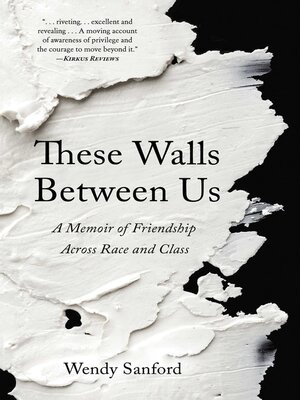
Sign up to save your library
With an OverDrive account, you can save your favorite libraries for at-a-glance information about availability. Find out more about OverDrive accounts.
Find this title in Libby, the library reading app by OverDrive.



Search for a digital library with this title
Title found at these libraries:
| Loading... |
From an author of the best-selling women's health classic Our Bodies, Ourselves
comes a bracingly forthright memoir about a life-long friendship across
racial and class divides. A white woman's necessary learning, and a
Black woman's complex evolution, make These Walls Between Us a "tender, honest, cringeworthy and powerful read." (Debby Irving, author, Waking Up White.)
In the mid-1950s, a fifteen-year-old African American teenager named Mary White (now Mary Norman) traveled north from Virginia to work for twelve-year-old Wendy Sanford's family as a live-in domestic for their summer vacation by a remote New England beach. Over the years, Wendy's family came to depend on Mary's skilled service—and each summer, Mary endured the extreme loneliness of their elite white beachside retreat in order to support her family. As the Black "help" and the privileged white daughter, Mary and Wendy were not slated for friendship. But years later—each divorced, each a single parent, Mary now a rising officer in corrections and Wendy a feminist health activist—they began to walk the beach together after dark, talking about their children and their work, and a friendship began to grow.
Based on decades' worth of visits, phone calls, letters, and texts between Mary and Wendy, These Walls Between Us chronicles the two women's friendship, with a focus on what Wendy characterizes as her "oft-stumbling efforts, as a white woman, to see Mary more fully and to become a more dependable friend." The book examines obstacles created by Wendy's upbringing in a narrow, white, upper-class world; reveals realities of domestic service rarely acknowledged by white employers; and draws on classic works by the African American writers whose work informed and challenged Wendy along the way. Though Wendy is the work's primary author, Mary read and commented on every draft—and together, the two friends hope their story will incite and support white readers to become more informed and accountable friends across the racial divides created by white supremacy and to become active in the ongoing movement for racial justice.
In the mid-1950s, a fifteen-year-old African American teenager named Mary White (now Mary Norman) traveled north from Virginia to work for twelve-year-old Wendy Sanford's family as a live-in domestic for their summer vacation by a remote New England beach. Over the years, Wendy's family came to depend on Mary's skilled service—and each summer, Mary endured the extreme loneliness of their elite white beachside retreat in order to support her family. As the Black "help" and the privileged white daughter, Mary and Wendy were not slated for friendship. But years later—each divorced, each a single parent, Mary now a rising officer in corrections and Wendy a feminist health activist—they began to walk the beach together after dark, talking about their children and their work, and a friendship began to grow.
Based on decades' worth of visits, phone calls, letters, and texts between Mary and Wendy, These Walls Between Us chronicles the two women's friendship, with a focus on what Wendy characterizes as her "oft-stumbling efforts, as a white woman, to see Mary more fully and to become a more dependable friend." The book examines obstacles created by Wendy's upbringing in a narrow, white, upper-class world; reveals realities of domestic service rarely acknowledged by white employers; and draws on classic works by the African American writers whose work informed and challenged Wendy along the way. Though Wendy is the work's primary author, Mary read and commented on every draft—and together, the two friends hope their story will incite and support white readers to become more informed and accountable friends across the racial divides created by white supremacy and to become active in the ongoing movement for racial justice.






